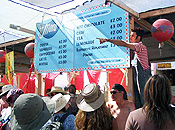For 2004, we augmented our team of returning veterans with the exciting addition of a new coffee shop manager, who brought fresh energy and perspective to the group. With so many experienced folks, we enjoyed the luxury of looking beyond the basics of setup/event/cleanup.
As a team, we defined three main focus areas for the year: (1) using decor and lighting to promote the idea that the Café is a place for people who are awake (reducing camping/crashing in the space), (2) improving our eco-friendliness by reducing trash, and (3) expanding participation by performers and better-utilizing the performance potential of the Center of the Center (the area in the middle of the Café, which lies at the middle of Center Camp).
The success of the overall visual design was tempered by difficulties related to some of the art installations. Also, bike-parking at the Café has created an increasing mess, and a smaller-than-expected clean-up crew strained the efforts of those who did volunteer.
Art, Decor, and Lighting
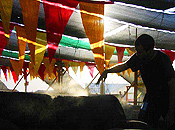 The Café Decor team experienced our best year overall since we formed in 2000. We designed “Café Sunspot” to express an encompassing solar theme as part of the Vault of Heaven art theme. We filled the space with “sun” colors of yellow/orange/red on furniture, flags, fabric, and lighting for visual unification of the sizable structure. In previous years, we had not been able to decorate the cables that support the shade cloth overhead, but this year they contributed to the decor by carrying strings of pennants.
The Café Decor team experienced our best year overall since we formed in 2000. We designed “Café Sunspot” to express an encompassing solar theme as part of the Vault of Heaven art theme. We filled the space with “sun” colors of yellow/orange/red on furniture, flags, fabric, and lighting for visual unification of the sizable structure. In previous years, we had not been able to decorate the cables that support the shade cloth overhead, but this year they contributed to the decor by carrying strings of pennants.
Volunteers also stepped up to design and build new Café furniture that works better than previous basic-box designs, both to discourage camping and to encourage more dynamic use of space. These new modular wooden benches were designed and built by Café volunteers in the spring of 2004, for the first time moving DPW helpers into an advisory role and reducing demands on their time. The design of this furniture and its placement significantly reduced the congestion so often found in the Café at busy times throughout the event. The new furniture design also supported intentional space for viewing art in the Café. The modular design anticipates future additions, simplifies painting, and allows storage between events, protecting the new furniture to avoid repainting (a massive time-saver!) and ensure that it will serve our needs longer than previous designs.
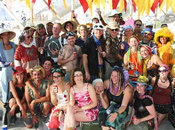 As a 24-hour café, we recognized a need to keep the space bright and active-looking at night, and careful lighting helped us succeed in this goal. The return of many high-level volunteers and team leaders allowed us to complete all projects on time — a first for us! This year we expanded this team to add several professional electricians and experienced theater lighting people, supplemented by collaboration with the creative minds of the decor team. We feel that this experiment of expansion was a grand success and merits a continued increase to the members of the lighting team in 2005. In addition to expansion plans, we also will continue to work to improve communication with remote volunteers to keep them involved in pre-playa preparations.
As a 24-hour café, we recognized a need to keep the space bright and active-looking at night, and careful lighting helped us succeed in this goal. The return of many high-level volunteers and team leaders allowed us to complete all projects on time — a first for us! This year we expanded this team to add several professional electricians and experienced theater lighting people, supplemented by collaboration with the creative minds of the decor team. We feel that this experiment of expansion was a grand success and merits a continued increase to the members of the lighting team in 2005. In addition to expansion plans, we also will continue to work to improve communication with remote volunteers to keep them involved in pre-playa preparations.
Returning volunteers contributed year-round during off-playa craft parties. In 2004, we fine-tuned these events based on a fundamental understanding of our annual goals and scheduling, as well as improved recognition of our volunteers’ skills. This learning process allowed us to exceed previous years’ achievements for project completion pre-playa. These changes created a much more efficient year for us on the whole.
This year, the café decor team benefited from much-improved communications and coordination between departments on-playa, sharing resources such as volunteers, equipment, and planning. These developments improved set-up time, worker morale, and our ability to plan based on more realistic estimates of timing. An example was the layout of the carpet, a huge task for the café space of 38,000 square feet. In prior years, everyone involved dreaded this day. With the merging of DPW and café forces, we had the smoothest carpet day yet, and those involved were still smiling after!
Café Art
The café art team had a mixed experience in 2004. Communication and coordination went better than ever in many areas, but we had problems with our primary installations — the portals and the back fence.
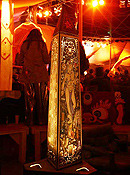 Our team’s coordination with the Artery has always been positive, but in 2004 the two groups achieved a more thorough understanding of how the café could accommodate art that would be in jeopardy on the open playa, usually due to weather elements and/or size of the installation. We also did a better job of communicating with artists on power needs, improving placement of art with relation to power availability and scheduling of “timed” installations (those using power only part of the day. Artists arrived well-prepared overall, even those who had not coordinated with the café team prior to the event, and a smooth system was in place to accommodate their needs. Many veteran artists contributed their experience with art on the playa and in the café itself, helping us to improve our preparations and placement.
Our team’s coordination with the Artery has always been positive, but in 2004 the two groups achieved a more thorough understanding of how the café could accommodate art that would be in jeopardy on the open playa, usually due to weather elements and/or size of the installation. We also did a better job of communicating with artists on power needs, improving placement of art with relation to power availability and scheduling of “timed” installations (those using power only part of the day. Artists arrived well-prepared overall, even those who had not coordinated with the café team prior to the event, and a smooth system was in place to accommodate their needs. Many veteran artists contributed their experience with art on the playa and in the café itself, helping us to improve our preparations and placement.
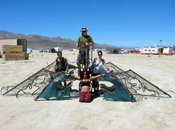 Our main struggles were with the portals and the art on the back fence. In both cases, the café structure visually overwhelmed the art, making it appear to have less effect than proposed and planned. The portal artist was unable to complete her installation with planned lighting and flame effects, further reducing its visual prominence at night. The scale of these important installations is an ongoing struggle, and we hope to improve the proportions and appearance of these elements by working more closely with the artists, defining the space in more detail in the proposal stages, and providing more concrete information prior to event setup. Another lesson we’ve learned is to get artists’ agreements and plans in writing before arrival on the playa to avoid surprises.
Our main struggles were with the portals and the art on the back fence. In both cases, the café structure visually overwhelmed the art, making it appear to have less effect than proposed and planned. The portal artist was unable to complete her installation with planned lighting and flame effects, further reducing its visual prominence at night. The scale of these important installations is an ongoing struggle, and we hope to improve the proportions and appearance of these elements by working more closely with the artists, defining the space in more detail in the proposal stages, and providing more concrete information prior to event setup. Another lesson we’ve learned is to get artists’ agreements and plans in writing before arrival on the playa to avoid surprises.
 The back fence suffered from its own unique problems. First, the fence was built longer than planned to accommodate operational considerations. As a result, the art placed there — which already had scale problems — did not nearly cover the entire fence. As we struggled to rearrange the art to expand its coverage, many event participants filled the space with their own markings. We are thankful that all the markings were around the art and not on it. However, the overall appearance of the fence became disconnected from the theme of the café space. Solving the “fence problem” is a priority for us in 2005.
The back fence suffered from its own unique problems. First, the fence was built longer than planned to accommodate operational considerations. As a result, the art placed there — which already had scale problems — did not nearly cover the entire fence. As we struggled to rearrange the art to expand its coverage, many event participants filled the space with their own markings. We are thankful that all the markings were around the art and not on it. However, the overall appearance of the fence became disconnected from the theme of the café space. Solving the “fence problem” is a priority for us in 2005.
Café Performance and Sound
As in previous years, the café housed a main music/performance stage and a smaller spoken word stage. The music stage scheduled acts from 8 a.m. to 3 a.m., leaving time in the afternoons and throughout the schedule for walk-up performers. The spoken word stage scheduled slots from 9 a.m. to 5 p.m. for a range of performance activities from poetry to theater to comedy to “playa news reporting and analysis.”
The sound system improved in 2004 through our investment in new equipment. This investment gives us an excellent base to build on for future years, and it remains available for year-round use at San Francisco events. Unfortunately, power conditioning problems damaged some equipment, so we’ll need to repair what we can and address power concerns in 2005 and beyond.
We also built a new sound booth in 2004, replacing our previous one-use facility with a modular and reusable structure. We reused the 2003 stage lumber, because the clean-up crew had stored it well the previous year. Also, we created a resilient (and reusable) sound system for the Backstage area of the coffee shop, allowing the busy and dedicated baristas to enjoy music for the entire week of the event.
The Sound Team added a volunteer coordinator in 2004, improving our recruitment and overall project management for the team. Our greatly expanded volunteer base brought us closer to our goal of creating a balanced team of sound technicians, both for the café and for year-round events, with full support for equipment, transportation, and clean-up. We still feel the need to reach an untapped community of sound technicians who may not be aware of our team; reaching them is a continuing goal for 2005.
The performance team worked to make good use of sound-system improvements by increasing the variety of performers utilizing the café space. In particular, we wanted to improve the use of the Center of the Center as a performance zone.
This year, we achieved a marked increase in aerial performers and large performance groups (including monkey chanters, hoopers, belly dancers, etc.). We rigged speakers behind the sound booth, which allowed us to project sound into the Center for the first time. We plan to increase this capability in 2005. In addition, the café rigging team set more attachment points for performers’ equipment, which allowed the acts more spatial flexibility in presenting their work. We also had a dedicated rigging team member available throughout the event week to assist aerial performers.
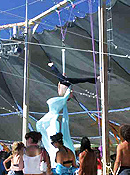 We worked more closely with performers pre-event, provided more support on-playa (equipment, transportation, etc.), improved the backstage “green room,” and enhanced our storage space. We created a team of stage managers to help coordinate the on-playa activities, orient performers, and document our processes. The new Volunteer Table served well in the afternoons as a focus for performer check-in and providing information.
We worked more closely with performers pre-event, provided more support on-playa (equipment, transportation, etc.), improved the backstage “green room,” and enhanced our storage space. We created a team of stage managers to help coordinate the on-playa activities, orient performers, and document our processes. The new Volunteer Table served well in the afternoons as a focus for performer check-in and providing information.
Coffee Shop
Our experienced team returned to the same basic physical structure we’ve been using since 2000, giving us an opportunity to focus on refinement of our operations. We closely examined the causes of past friction and inefficiency in an effort to smooth our work processes.
We reviewed the design of the serving floor in an effort to create an environment that would satisfy both the utilitarian need for an efficient space to make 80,000 cups of coffee and the more ephemeral aim of creating a positive place for hundreds of volunteers to contribute. Expanding the space behind the counter gave everyone more room to move around. For the first time, we also built a shaded structure in the backstage area where volunteers could store their bags, gather for orientation between shifts, and take brief breaks from the mad dash that characterizes the café during daylight hours.
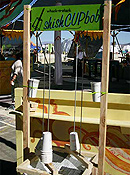 We also gave serious thought to the ecological impact of our activities. After many years of asking, this year we finally got health department approval to serve coffee in people’s personal mugs. Very few people took advantage of the new opportunity this year, but we will continue to promote the idea, hoping for significant reductions in the amount of waste our disposable cups generate. We further improved our eco-grooviness by introducing the “shishCUPbob” — a device that allowed us to collect the paper cups that we provided without collecting random trash. By the end of the week, the shishCUPbobs were grimy, but they accomplished their job in a beautiful way. We collected just a fraction of the non-Café trash that had previously been prevalent in café trash cans during past years, and we were able to dump waste liquid into our greywater tanks for pumping, rather than encasing it in plastic bags and paying to have it hauled away to the dump.
We also gave serious thought to the ecological impact of our activities. After many years of asking, this year we finally got health department approval to serve coffee in people’s personal mugs. Very few people took advantage of the new opportunity this year, but we will continue to promote the idea, hoping for significant reductions in the amount of waste our disposable cups generate. We further improved our eco-grooviness by introducing the “shishCUPbob” — a device that allowed us to collect the paper cups that we provided without collecting random trash. By the end of the week, the shishCUPbobs were grimy, but they accomplished their job in a beautiful way. We collected just a fraction of the non-Café trash that had previously been prevalent in café trash cans during past years, and we were able to dump waste liquid into our greywater tanks for pumping, rather than encasing it in plastic bags and paying to have it hauled away to the dump.
Ice has always been an important commodity for use in iced beverages and for storage coolers. In past years, the café patronized CampArctica, drawing from the same inventory that serves participants during the event week. For 2004, we joined with the Commissary to acquire a separate, more conveniently located cache of ice that we could tap in bulk. This innovation eliminated the need for volunteers to cross Center Camp throughout the day toting small amounts of ice, and it prevented us from competing with participants for a commodity that both need. This method was much more efficient for all concerned and will be continued in 2005.
Despite operational improvements, the café’s capacity to serve coffee seems to have reached a maximum for our current set-up. During 2004, we no longer experienced a proportional relationship between the growth of the city’s population and the amount of coffee we serve. For the past two years, we have served roughly the same amount, despite growth of approximately 10 percent in Black Rock City’s population. Unfortunately, we had planned on needing about 10 percent more supplies, mostly milk, and we didn’t use all of it. Now that this maximum service capacity for the café is known, we can plan for it and avoid wasting resources trying to supply more.
The coffee shop alone kept more than 300 volunteers hopping through more than 1,000 shifts. Our reliable returning rockstars joined with lots of Black Rock City newbies to meet the city’s vital need. These many dedicated volunteers are the driving force of the coffee shop, but the painstaking and time-consuming job of coordinating and scheduling their work has become too much for a single person, who is, of course, one of our volunteers and must juggle other responsibilities. One-on-one pre-playa communications have helped tremendously to keep volunteers well-informed and effective, and to nurture their connection to the team. But, the time commitment for good coordination needs to be spread out somehow among a wider team. Solving this problem will be one of our biggest priorities for 2005, and work has already begun to define alternatives and tools.
Our volunteer coordination and management processes matured in 2004 with the implementation or expansion of a number of successful new tools. We expanded our successful experiment with co-shift-managers to cover nearly all of our shifts during the week. The Volunteer Table became a more visible reference point for all café volunteers, artists, performers, and the general public. New for 2004, on-playa volunteer coordinators conducted pre-shift volunteer check-ins and orientations, which greatly improved our shift transitions. The café operations team held several on-playa meetings to share information, develop consistent expectations, forge a common understanding of policy, and solve problems with confidence once the event began.
Our new Operations Manager contributed another valued tool — a bullhorn, which was quickly co-opted by the volunteer coordinator. Every time we used the bullhorn to make announcements at the Volunteer Table (or elsewhere in the café), we received excellent responsiveness. The radio was another exceptionally useful tool for directing questions to the most appropriate people. This communication greatly improved the coordination between the members of our team.
Aside from the coffee shop menus, all signs were made from scrap wood, including old signs that had been repainted. The thematic menus and counter signs were all prepared and completed prior to arriving on the playa, largely due to some amazing volunteer support. After working with the same team for 4 years, we started with a good idea of requirements for user-friendly coffee shop signage. “Line modifier” signs helped to direct people to the appropriate lines for their orders. These signs successfully conveyed information, although more extensive staff training will help to maximize communication effectiveness.
With the growing emphasis on space-efficient decor and accommodating the most people possible, we increased the number of “No Bikes” signs surrounding the perimeter of the café. Hand-painted signs from years past were supplemented with new hand-painted signs as well as vinyl-lettered signs from the Burning Man Sign Shop.
We also needed new two-sided signs for each of nine stations in our new cup disposal system, the Whack-n-Stack ShishCupBob.
We did notice room for improvement in how the signs are hung over the coffee shop counters. Heavier cable is needed so that they can withstand the handling they incur through having the line modifier signs constantly changed on top of them. To maintain economy of materials, all signs are made to be re-used for years to come.
Café Community
This year we received many enthusiastic inquiries from participants wanting to work with the café. All incoming volunteer communications received careful responses and routing to appropriate team leaders within the café team. As always, most folks are interested in volunteering specifically with the coffee shop. Each team leader did a great job of handling the high volume of incoming volunteers. As a result, all café teams did the best job ever of pre-scheduling volunteers for shifts long before anyone reached the playa.
In addition to our ongoing efforts to place and organize volunteers, 2004 was our third year of organizing café Village, our centrally placed home for café staff and dedicated volunteers. After outgrowing our plot size from 2003, we requested a larger plot this year, and we used every square inch. For the first year, café Village welcomed Burning Man Commissary staff in an enclave we lovingly called the “Commissary Clatch.” They were a great addition and helped to diversify the culture of the village a bit.
The physical layout of the Village worked well for the most part. As new arrivals pushed our layout to the brink of overcrowding, we struggled to maintain pathways for circulation and vehicle movement. Fortunately, the villagers rose to the task of helping to place latecomers and to educate folks about the need to keep clear pathways.
Our larger village allowed us to have more communal shelters this year than ever. Returning builders from previous years did an effective job of setting up communal structures.
This year the village housed a wonderful mix of staff and volunteers from all over the world. Prior to arriving on the playa, villagers received several informational emails. This communication helped to inform everyone about the space and amenities available to them, and about their LNT responsibilities, as residents of café Village. This strategy proved to be an effective way for everyone to set reasonable expectations and also to ask any questions while making their preparations. As a result, everyone in the village did a fabulous job of cleaning their personal camp areas as well as contributing to the clean up of the village on the whole.
As a complement to our campaign to better prepare and educate villagers, additional time was spent on organizing the infrastructure. A positive innovation was a Mayoral Council system for the village. This system ensured that numerous people would be available at most times to help place incoming villagers and remind them of their responsibilities, while answering any questions.
While the year was a great success for the village, a few areas leave room for improvement in 2005. We were sorely disappointed to learn after the fact that our neighboring theme camp had blatantly lied to us and leached power from our limited supply throughout the entire event. We will more vigilantly monitor use of our power supply. Also, the Mayoral Council system can be greatly enhanced by more specific assignments of tasks and shifts. We faced constant challenges trying to get our shower to work properly, since we were relying on hand-me-down plumbing. Next year, we should plan ahead and budget to purchase our own plumbing needs upfront to make sure that staff and hard-working volunteers can take showers.
Cleanup
After the event, the café team has about a week to take everything apart, store it in containers, and get the containers off the playa, while making sure we leave nothing behind. This year, while we did indeed finish, we struggled. We did not have as large a turnout for cleanup week volunteers as we had hoped. Several theories have been suggested to explain this result, including harsh weather during the event and exhaustion among volunteers who had worked so hard during set-up week. Whatever the reason, several volunteers who had committed to work with us during cleanup retracted their promises. We are currently brainstorming ideas to recruit and keep volunteers to contribute during this vital week after the event.
The Decor team produced a protocol for set-up week volunteers that will be repeated in following years. This practice improved our handling of scheduling, meals, early arrival entry through the Black Rock City gates, etc. Our goal is to create a similar protocol for cleanup week that will set guidelines and assist us with recruitment of volunteers.
Clearly, though, burnout among our incredibly dedicated team members affected cleanup. Many who worked during set-up to build the coffee shop also toiled during the event to run it, and they were then expected to stay after to help with cleanup. In an environment as harsh as the Black Rock Desert, 3 weeks of work is a lot to ask of anyone. To remedy this situation, it is now clear that people should not be expected to work both during set-up and during cleanup. In the future, we plan to make sure that two distinct groups of people are scheduled for set-up and cleanup to limit burnout.
Submitted by,
Dana Harrison
With submissions by Marcia Crosby, Bonnie Schneider, Marie Gerrard, Tom Kapanka,
Sean McCormick and Rebecca Throne


